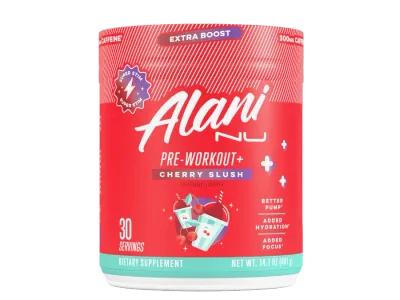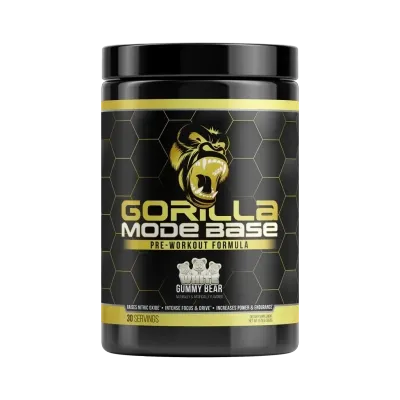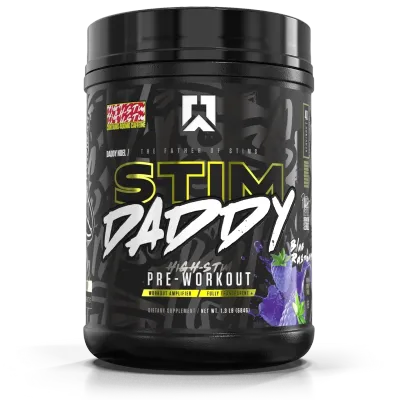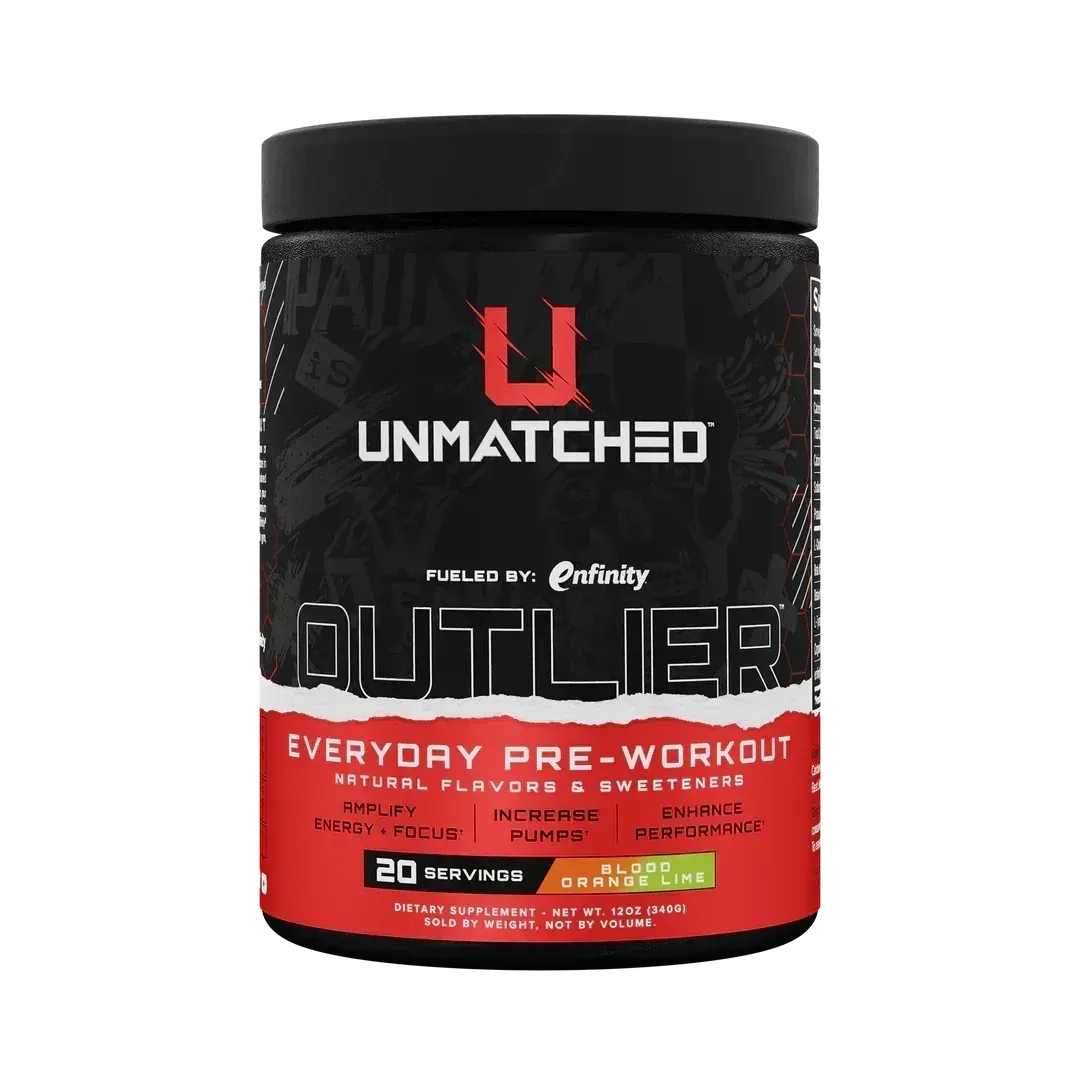🚚 Free Shipping on Orders $49+
Unmatched Supps Outlier
$34.99
Bulk pricing available for quantities of 2 units or more
Everyday pre-workout with paraxanthine, Cognizin®, and NO3-T®
Flavor
Size
In stock
1
Enjoy automatic savings when you buy more of the same item — identical size and flavor required to qualify.
| Quantity | Price per item | Discount |
| 2 items | $31.49 | 10% off |
Save to Favorites
Customer reviews
Reviews only from verified customers
No reviews yet — buy it and be the first to share your feedback. Every review = a chance to win 200 loyalty points.
Unmatched Supps Outlier
Product Details
Brand: Unmatched Supps
Form: Powder
Goal: Fuel Workout Energy
Stim Strength: Moderate-Stim
Serving Size: 1 Scoop
Unmatched Supps Outlier Everyday Pre-workout
- AMPLIFY ENERGY + FOCUS*
- INCREASE MUSCLE PUMPS*
- ENHANCE PERFORMANCE*
Outlier is an affordable everyday pre-workout. Providing superior pumps, heightened mental focus, and euphoric energy. Taking your training, sports and physical activities to the next level.
Outlier Key Ingredients:
L-Citrulline
Citrulline is a non-essential, non-protein amino acid that forms during the urea cycle and forms ornithine when combined with carbon dioxide. Citrulline is also a critical source of endogenous (natural) arginine, as it is rapidly and efficiently converted to arginine in the vascular endothelium and other tissues.
Citrulline’s benefits have been shown to be greater than its parent compound. While arginine undergoes direct hepatic (liver) metabolism through the enzyme arginase, citrulline bypasses hepatic metabolism entirely and it is delivered straight to the bloodstream. The result is that gut absorption and plasma (blood) bioavailability studies comparing citrulline and arginine have shown two things. First, citrulline is less readily destroyed and has greater absorption than arginine. Second, citrulline supplementation increases arginine levels more effectively than arginine supplementation itself.
This translates to promising results. For example, animal studies show a significant increase in anaerobic performance at a 250mg/kg/day serving of citrulline, while studies in humans implicate citrulline in both aerobic and anaerobic performance increases. As a critical part of the urea cycle, citrulline’s performance benefits are thought to be a result of its role in ammonia clearance. Citrulline is implicated in reducing the oxygen cost of muscle processes, along with increasing the rate of post-exercise ATP and phosphocreatine replenishment. As ATP and phosphocreatine are the body’s ‘exercise fuel,’ this may result in citrulline delaying time to exhaustion in aerobic and anaerobic exercise.
Beta Alanine
Carnosine is a bit of an odd duck: we know that it is crucial for muscle function, and that dietary sources of carnosine are essential, but we don’t know precisely how it’s working. Moreover, for decades, we had no idea how to increase intramuscular concentrations, as exogenous carnosine sources degraded in the body so fast as to be effectively useless.
Enter beta-alanine. Simply a different iteration of one of the amino acids that comprises carnosine itself (alanine), beta-alanine has proven to be the most effective means of significantly increasing intramuscular concentrations of carnosine – and therefore of promoting all of carnosine’s various beneficial effects on muscle performance. If that weren’t enough, beta-alanine has also demonstrated beneficial physiological effects independent of its parent compound. To understand why, though, we need to first understand some of the basics behind carnosine itself.
Carnosine, a cytoplasmic dipeptide synthesized from the precursors L-histidine and l-alanine, is present in high concentrations in skeletal muscle and plays a pivotal role as a, “chemical buffer” in myocytes (muscle cells). It has long been known that carnosine concentrations are highest in glycolytic, rather than oxidative muscle fibers (roughly speaking, explosive vs., endurance muscle fibers, respectively), and thus long hypothesized that this amino acid is required for sustained performance during supramaximal exercise. Recent research demonstrates that carnosine exerts its physiological effects in long hypoxic (low oxygen) drives by functioning as a high-capacity pH buffer in skeletal muscle, preventing the pH ratio of plasma from dropping too low – and therefore preventing crucial pH-dependent processes such as protein synthesis from being inhibited by acidosis.
Despite its critical role in skeletal muscle anaerobic performance, intramyocellular synthesis of carnosine is rate-limited by the availability of l-alanine. Unfortunately, the majority of literature demonstrates that attempting to increase intramuscular levels of carnosine via either direct carnosine or alanine supplementation is largely ineffective due to carnosine/alanine pharmacokinetics. Enter beta-alanine. Research with beta-alanine demonstrates consistent and dose-dependent increases to intramuscular carnosine concentrations with beta-alanine supplementation, with certain studies showing an increase of 40-60% with chronic administration. These same literatures reveal a synergistic effect of exercise on beta-alanine supplementation, whereby the muscle adaptive changes associated with resistance training promote further intramuscular carnosine production in response to beta-alanine supplementation.
In simpler language, this essentially means that beta-alanine is a dietary supplement that promotes its own effects in combination with exercise. As you exercise, you simultaneously intensify beta-alanine’s physiological actions – both directly, as well as in the production of intramuscular carnosine. Once ingested, beta-alanine’s exercise-specific beneficial activity is well-established. Elevation of intramuscular carnosine content via beta-alanine supplementation has been shown to improve performance in the following ways.
- Both acute and chronic increases in total work capacity, measured by total volume during exercise sessions.
- Highly significant increases to TTE (total time to exhaustion), one of the most accurate and comprehensive measures of endurance. In various trials, beta-alanine supplementation has been shown to increase TTE by upwards of 20%.
Increases to total muscle power output in both acute and chronic trials, suggesting that beta-alanine’s most significant benefit is to those engaging in power-dependent resistance training.
In total, a significant body of research exists to suggest that beta-alanine may significantly increase muscle power output, strength, training volume and output, overall performance in hypoxic (oxygen-deprived) conditions and peak VO2 max (oxygen holding capacity).
These myriad benefits make beta-alanine both one of the most-studied, and most well-rounded dietary supplements. Beta-alanine not only has direct, actionable physiological effects, but also promotes critical muscle physiologic adaptations that promote its own effects.
Betaine Nitrate (as NO3-T®)
Betaine (trimethylglycine) is found naturally in most living organisms. It is well known to protect non-mammalian animal life in conditions of osmotic stress (a rapid change in the amount of solute surrounding a cell), in addition to functioning as an osmolyte in mammalian (including human) tissues\. Betaine is formed in cells as an oxidation product of choline and can be obtained in the diet from foods such as spinach and beets.
Though data on betaine is limited, and recent, the available literature suggests that this compound may have effects in a number of areas. Studies on betaine using servings as little as 1.25g/day and up to 5g/day for up to 14 days have shown promising results. In one study, a 2.5g/day serving was found to enhance endurance and total repetition volume for the squat, bench press, and jump squat in in healthy-exercised trained adults. A similar study using the same serving found that betaine use increased peak power and maximum peak power, along with force and the maintenance of both force and power in healthy, exercise-trained subjects.
Perhaps more interesting, however, is a study which examined betaine’s effect on the endocrine system. This study revealed that betaine may exert an effect on several endocrine processes given the proper conditions, causing the authors to hypothesize that long(er) term betaine supplementation may increase the hypertrophic response to resistance training.
Pairing betaine with the patented nitrate (N03-T®) enhances nitric oxide production via the nitrate-nitrite pathway. Organic nitrate esters have a direct relaxant effect on vascular smooth muscles through non-nitric oxide synthase pathways, being directly converted first to nitrites and then to nitric oxide itself. (With attendant increases to guanylyl cyclase and then cyclic guanosine monophosphate (cGMP), which relax the vasculature.) Pairing both nitric oxide synthase and non-nitric oxide synthase-dependent mechanisms of actions theoretically enhances total NO production, given that rate-limiting enzymatic pathways in either mechanisms do not determine total NO production.
In an absolute sense, both inorganic and organic nitrates also possess benefits beyond a secondary NO-production pathway. Studies in athletes have demonstrated that nitrate ingestion prior to both aerobic and anaerobic exercise meaningfully increases both delay to fatigue and total work capacity – likely a consequence of nitrate’s activation in hypoxic (oxygen-deprived tissues). Nitrate effectively reduces the oxygen cost of muscular activity, making contractions more efficient.
L-Tyrosine
Tyrosine is amongst a class of amino acids known as ‘non-essential’ amino acids, so called because the body can produce them endogenously, and it is therefore not essential to consume dietary tyrosine. That said, tyrosine is also what is known as a conditionally-essential amino acid; conditionally-essential because, along with glucose and ammonia, the synthesis of tyrosine additionally requires adequate levels of phenylalanine. Once synthesized, tyrosine is one of the most critical amino acids, given its prominent role as a substrate in the synthesis of the catecholamines dopamine, norepinephrine, and epinephrine, in addition to both T3 (triiodothyronine) and T4 (thyroxine) thyroid hormones.
In studies on stress modulation, tyrosine has been demonstrated to reverse stress-induced norepinephrine depletion and the depressant-behavioral effects normally associated with it. In simpler terms, tyrosine may, in certain conditions, dampen the extent to which norepinephrine is removed from the bloodstream during a stress event. In simpler terms still, tyrosine may help to mitigate the sense of depletion and fatigue felt at the end of a workout.
Tyrosine may also play important metabolic functions, mostly related to its role in synthesizing compounds which stimulate the nervous system. While not traditionally considered a sympathomimetic amine, studies which have coadministered tyrosine and stimulants demonstrate a synergistic effect. These studies suggest that tyrosine may potentiate the effects of both endogenous and supplemental norepinephrine and its mimetics (in the case of exogenous use) with respect to lipolysis, thermogenesis, and energy expenditure. Meaning that tyrosine may play a role in assisting norepinephrine to break up triglycerides and increase body heat transiently.
Cognizin® Citicoline
Choline is an essential nutrient involved in numerous metabolic pathways, including DNA regulation and repair, protein function, and metabolism. Perhaps most importantly, the critical neurotransmitter acetylcholine is produced directly from free choline via cholinergic neurons. Acetylcholine is then responsible for several functions itself, most crucially as the compound which induces muscular contraction, and as the neuromodulator partially responsible for modulating risk/reward, arousal, and enhancing memory.
Choline’s essential role as a substrate for acetylcholine, and therefore brain development, is well documented in animal models. These studies demonstrate that levels of free maternal choline have a direct and fundamental impact on prenatal brain development, with the enhancements or deficits lasting into adulthood. Choline’s enhancing effect is particularly prominent in the hippocampus. In humans, the hippocampus is primarily involved in the consolidation of memory (taking short, episodic memory and translating it into long-term memory) and the learning of new information. Acetylcholine is a critical component in these processes, as mentioned above, and choline may therefore play a potential role in these processes as well by providing the substrate for acetylcholine synthesis.
Citicoline (Cytidine 5’-diphosphocoline), also known as CDP-choline, is a potentially superior form of choline due to its ability to cross the blood brain barrier. In fact, most studies with neurological or nootropic effects used this form. In that regard, studies in otherwise healthy, normal adults demonstrated meaningful and statistically significant impacts on working memory, recall, and attention. We have chosen to use the clinically tested, Cognizin®, in this premium formula as our primary choline source. Unlike other synthetic stimulants that can cause a rapid decline in effectiveness after an initial burst of energy, Cognizin® can offer critical nutritional support for the brain that can help support needed focus and attention.
enfinity® Paraxanthine
Caffeine is widely known as being the world’s most popular dietary supplement ingredient. It provides energy and wakefulness through a process of inhibiting phosphodiesterase and adenosine. What most people don’t know however is, is that caffeine is made up of three powerful metabolites one metabolized by the liver, Theobromine, Theophylline, and Paraxanthine. Paraxanthine is the star of the show here as it does a large majority of the heavy lifting for caffeine’s felt effects, such as lipolysis, as well as the actual dopamine upregulation and feel-good effects we experience when taking caffeine. Paraxanthine also has stronger binding potencies for adenosine as well as can increase processing speed, improve response time, and promote more sustained attention during activities.
One of the most attractive qualities about paraxanthine is that it has a substantially shorter half-life than both theophylline and theobromine. At 3.1 hours, its less than half of the half-life, which leads to caffeine’s general half-life being around 4.1 hours. The one thing about caffeine in general is that its metabolism varies across genetic and ethnic distributions, so not everybody is going to react the same to the same amount of caffeine at the same times taken. In fact, there are fast, medium, and slow metabolizers of caffeine. From person to person, this can mean that caffeine’s half-life can vary anywhere from 1.5-10.5 hours. However, some research has shown that caffeine clearance can vary as much as 40x between consumers. What anecdotal evidence is showing when all these individuals ingest paraxanthine, is that it leads to a much smoother and consistent experience for everyone. The shorter half-life works great for slow metabolizers too, especially without them having to worry about the consequences of theobromine and theophylline lingering around. Although studies on paraxanthine are preliminary, the evidence thus far points to the substance being a reliable replacement to traditional caffeine for those who are widely affected by caffeine’s addictive and often negative side effects.
You May Also Like
Everyday Low Price

Alani Nu Pre-Workout +
Alani Nu Pre-Workout +
Boost energy, hydration, and focus with a 300mg caffeine punch
List Price: $44.99
Save 20%
$35.99
Everyday Low Price

Merica Labz x Panda Supps First Blood Pre-Workout
Merica Labz x Panda Supps First Blood Pre-Workout
Intense pumps and explosive energy, limited edition
List Price: $59.99
Save 8%
$54.99
Sold out

Gorilla Mind Gorilla Mode Base
Gorilla Mind Gorilla Mode Base
Powerful daily pre-workout with 10g Citrulline for insane pumps
$34.99
🔥 Clearance Deals

Ryse Stim Daddy Pre-Workout
Ryse Stim Daddy Pre-Workout
21g formula with caffeine, Dynamine®, and Cognizin®
List Price: $56.99
Save 4%
$54.99
Display prices in:USD


